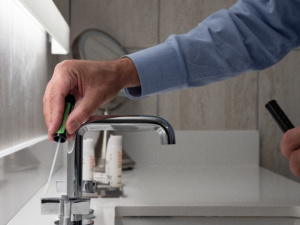BOISE – During the COVID-19 pandemic, the hotel industry put increased emphasis on cleaning programs to help protect the health and safety of guests. But how can travelers feel more confident that these programs are being properly implemented?
In response to requests from the public, AAA is launching a new “Inspected Clean” program to independently confirm that hotel surfaces have been cleaned to within acceptable standards. As part of the approval process, one of AAA’s full-time inspectors will test for the presence of Adenosine Triphosphate (ATP) on eight surfaces in guest rooms and bathrooms before issuing a Diamond Designation to the hotel property.
ATP is an energy-carrying molecule that is found in the cells of all living things, including food sources, human skin cells, bacteria, and mold.
“An ATP test will not reveal the specific source of contamination, but it almost instantly detects unacceptable levels,” says AAA Idaho public affairs director Matthew Conde. “A hotel room doesn’t have be ‘hospital grade’ to be safe, but it should live up to the expectations of AAA, the hotelier, and the traveler. ATP testing can play a critical role in that effort.”
When a AAA inspector arrives at the hotel for an unannounced inspection, he or she will test several surfaces in randomly selected rooms by swabbing a surface and then adding the sample to a vial containing a special testing chemical. The vial is then inserted into a portable test machine that is about the size of a large cell phone. Results are reported in a matter of seconds.

If a surface doesn’t meet AAA’s established cleanliness standards, the inspector will perform a re-test of the same surface in another room. Properties that fall short on any portion of their inspection will not receive AAA approval and will need to resolve cleanliness concerns before applying for a re-test and reinstatement.
To establish a range for cleanliness standards across the industry, AAA analyzed data collected from a pilot program consisting of 11,000 ATP surface tests in more than 1,000 hotels. Baseline scores were generally strong and closely aligned with other aspects of AAA’s physical inspection process.
Test surfaces may include door handles, light switches, thermostat controls, TV remotes, refrigerator handles, faucet and toilet handles, vanity surfaces, hair dryers, and more. In AAA’s pilot program, vanity surfaces and toilet handles showed lower levels of ATP, while thermostats and TV remotes showed higher levels.
All AAA Diamond-designated properties must now qualify as Inspected Clean. Diamond designations (Approved, Three Diamond, Four Diamond, and Five Diamond) are based on the number of amenities and services that the property provides in addition to established standards of quality, cleanliness, and hospitality.
“ATP monitoring is recognized by the Centers for Disease Control and Prevention and National Institutes of Health, and is regularly used in healthcare, food service, education, and other industries that prioritize effective cleaning and sanitation,” Conde said. “AAA, the hotel property and the guest all want the same thing – a clean, comfortable stay. We’re pleased to use this proven technology to help achieve that goal.”
For more than 80 years, AAA’s independent, full-time inspectors have provided objective, in-person property inspections that travelers can trust. AAA currently inspects more than 59,000 hotel and restaurant properties across the U.S. and Canada. Diamond designations can be found in AAA’s print and digital TourBooks, and on the AAA mobile app.
The AAA Inspected Clean program will officially launch on June 28, with AAA inspectors returning to the field to educate hoteliers in time for the busy 2021 summer travel season.

